|
|
The
Plant of the Week
This feature
is being continued here.
(images with informative captions)
*
| Lonicera
fragrantissima - Winter Honeysuckle - Shrub
There are flowers year-round
in my landscape, even now, in late January. These photographs were
taken a few days after our recent ice storm. And, though these blooms
are small and lack pigment, their fragrance is a sensory delight.
They are borne by the hundreds on a large, mounding shrub, semi-evergreen
in its mid-winter repose. This native of China belongs to the genus,
Lonicera,
the Honeysuckles, but it does not engage in the family business of twining
and climbing. It is a shrub to 8' to 10' high by up to 12' wide in
our area. To find one, go to any of the old neighborhoods of San
Antonio, get out of your car and follow your nose. |
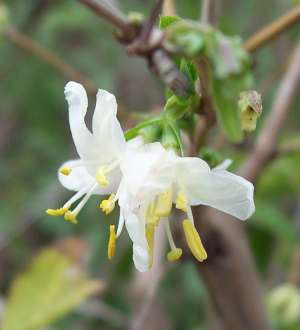 |
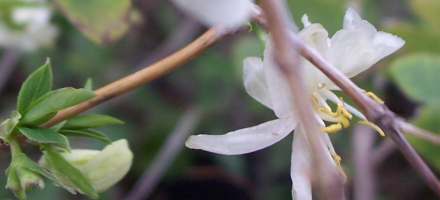 |
The "Plant of the Week"
will be on vacation until I resume doing gardening shows on the radio.
Thank you for visiting this page.
|
|
|
|
Previous
Plants-of-the-Week:
|
|
| Quisqualis
indica - Rangoon Creeper - Perennial Vine
I rank this as one of the
top flowering vines for San Antonio and Austin. This tropical species can
be seen in many old gardens, attesting to its hardiness and longevity.
In fact, my specimen along the southeast side of the house has not frozen
back in three years. And, it was still flowering when covered by
ice earlier this week. It generally blooms from April until the first
hard freeze and its petals darken from white to red as the flowers age.
Grows in full sun to half-day sun. It requires a tall and substantial
tree or trellis to climb. While it is drought-tolerant, it looks
best (and bears more flowers) if given a deep watering every two weeks
during a dry summer. |
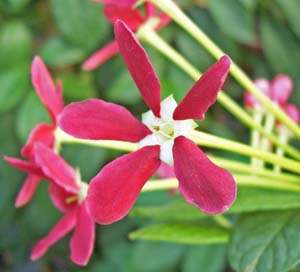 |
|
|
| Bignonia
capreolata - Cross Vine - Vine
One of the showiest evergreen
vines for our landscapes is also a native plant. It climbs trees
in a large zone of the eastern U. S. framed by lines connecting Texas,
Florida, Virginia and Illinois. This photograph shows two of the
extremes in its range of floral tones. The stems cling to almost
any irregular surface with a network of clawed tendrils, but are not known
to damage walls. Though they generally are found in shady sites,
they can prosper in almost full sun if ample irrigation is provided.
This species should not be
confused with the related Trumpetvine, Campsis radicans, a pernicious
weed with deciduous leaves. It usually flowers in the summer, but
the Cross Vine blooms in spring. |
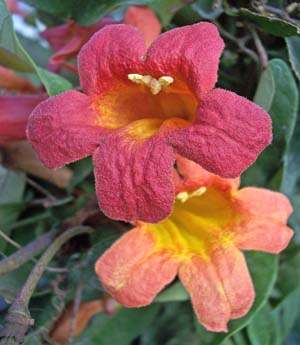 |
|
|
| Salvia
madrensis - Big Yellow Sage - Perennial
Named for the Sierra Madre,
this is one of the giants of the root-hardy Salvias, reaching up to 10
feet in late fall as the large spikes of sticky, yellow blooms appear.
And, thanks to the mild weather so far this winter, this plant is still
flowering the first week of 2007. The sturdy stems are shaped like
I-beams that alternate orientation at each node. Each node bears
a pair of large leaves displaying prominent venation. Well-established
clumps produce several upright stems, creating a massive presence in the
landscape. For best results, give it afternoon shade and mulch it
deeply before a hard freeze. |
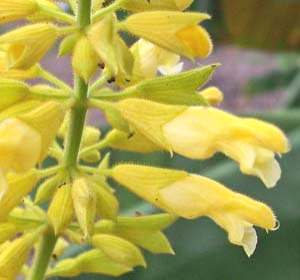 |
|
|
|
|
|
| Dahlia
imperialis - Imperial Tree Dahlia - Perennial
If the phrase, Tree Dahlia,
strikes you as oxymoronic, you are not alone. Few are aware that
high in the Sierra Madre of Mexico live several species of Dahlia that
do reach arboreal dimensions. My tallest plants of this species have
grown to just 16', about one-half of their genetic potential. They
thrive with late afternoon shade, good drainage, abundant fertilization
during the growing season and a long, mild fall without early freezes.
Their only problem in our zone is the habit of starting to flower after
the middle of October. But even if you have just a week or
two to enjoy their 6" to 8" diameter flowers, you have had several months
to taunt your friends with frequent boasts of, "Mine is bigger than yours!" |
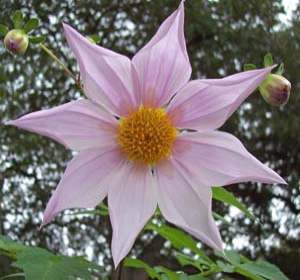 |
|
|
| Quercus
buckleyi - Hill Country Red Oak, Spanish Oak, Texas Red Oak - Tree
First, the good news about
this extraordinary tree. Specimens of this species are showing truly
spectacular fall color this week. Now, the bad news. They are
not so attractive every year and some have brown, dead leaves that persist
all winter until newly emerging leaves pop them off. But, for the
really bad news,
Quercus buckleyi is the Typhoid Mary of the current
epiphytotic of Oak Wilt in this region. So, if you still want one
for your landscape, go to your favorite nursery today and select one with
the best genetics for fall foliage (see range of variation in fall color
in these photographs).
Other Oaks with similar foliage
and the same susceptibility to Oak Wilt include: Quercus canbyi
(Canby's Oak, Sierra Red Oak), Quercus gracilliformis (Chisos Red
Oak), Quercus sartorii (Sartor's Oak) and Quercus sillae
(Saddle Mountain Oak). The above recommendations to not apply to
Shumard's Red Oak, Quercus shumardii, it does best in east Texas. |
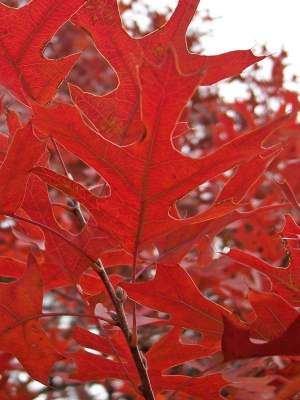 |
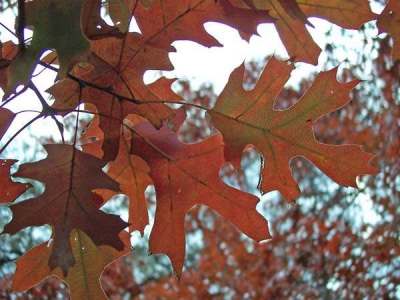
|
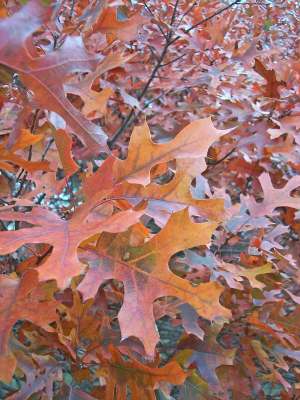 |
|
|
| Odontonema
strictum - Firespike, Guatemalan Hummingbird Bush, Hummingbird Bush - Perennial
Season's greetings from Central
America! What a spectacular late fall to early winter floral display
that ends so suddenly with the first freeze. Or, it could continue
in a greenhouse or very protected microhabitat. This relative
of the Shrimp Plant is a root-hardy perennial but, regrettably, its
late season bloom seldom runs its course in our latitude. But that
doesn't stop me from including it in some of the afternoon-shade borders
in our landscape. Though it freezes to the ground most winters, it
can still reach 6' by late fall and usually provides at least 2 to 3 weeks
of tubular flowers before all its aerial parts are blackened by an arctic
blast. It grows best with 3 to 4 deep soakings per month during the
growing season and 2 to 3 feedings with 15-5-10 fertilizer in spring
and summer. And, if the current 12,000 year trend of global warming
during this interglacial period continues, it will have an even longer
blooming season here in central Texas. |
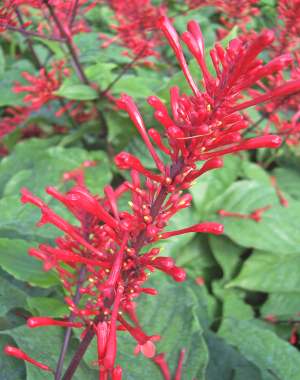 |
|
|
| Citrus
X Changsha - Citrus reticulata X Citrus ichangensis - ChangSha Tangerine
- Shrub
The 2" to 3" diameter fruit
(up to 4" diameter if thinned), which ripens mid- to late-November, has
less flavor than supermarket tangerines and is seedy. So, why do
we grow it? Because it is the cold-hardiest, commercially available,
edible citrus for San Antonio and Austin. If acclimated, it is hardy
to 15º F. or lower (seedling plants, but not grafted ones, have resprouted
from below after the tops were killed at 4º F.). Old specimens
in this area grow to almost 20 feet high and almost as wide, if not pruned.
The Changsha Tangerine also makes an outstanding hedge if planted 8' apart.
Caution, branches heavily laden with fruit (see photograph) will bend down
and could break during a storm!
It is thought to be a very
old hybrid of Citrus reticulata, the Mandarin or Tangerine, which
if acclimated, is hardy to 20º F., and Citrus ichangensis,
the Ichang Papeda, a tree with inedible fruits. If acclimated, hardy to
0º F.
Does best in full sun, in
soils with good internal drainage. Performs best if given a deep
watering every two weeks during a dry summer. |
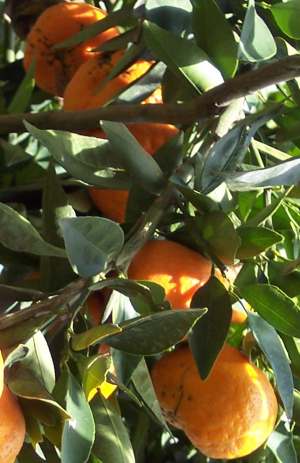 |
|
|
| Eupatorium
odoratum - Fragrant Boneset - Perennial
The specimens of this native
perennial in my collection are propagations from plants collected near
the northernmost location of this primarily tropical American species,
in a rattlesnake-infested prairie near Goliad. Though they do not
grow as large as those seen farther south, they will become 6' to 8' high
and wide mounds of lavender-blue flowers in October, just in time to provide
nectar for the multitude of Monarch butterflies returning to the high mountains
of southern Mexico for the winter. I am thankful that this year,
they are still blooming here on Thanksgiving weekend. They are quite
adaptable, growing in full sun to half-day sun and are drought-tolerant
once established, as well as being tolerant of rocky soils. |
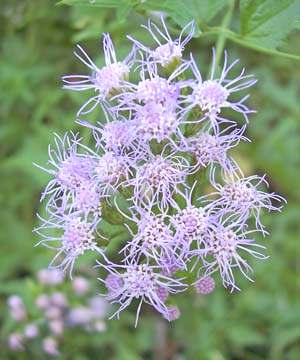 |
|
|
| Cassia
splendida - Golden Wonder - Shrubby Perennial
While it can grow up to 8'
to 10' high and wide, I include it with perennials since I cut mine back
to the ground whenever it gets too big or we have had a severe winter.
These are often seen in old gardens because they are so durable and can
survive with no human attention once they are well established. Do
not fertilize them since they are in the Legume Family, but do provide
mulch around their base. They grow and bloom best in full sun but
they can also provide an acceptable floral display in half-day sun.
If you had one in your landscape, it would be spectacular this fall!
|
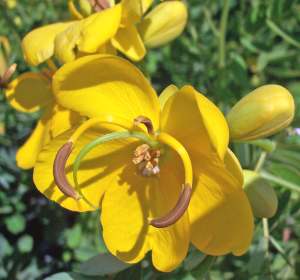 |
|
|
| Alstroemeria
psittacina 'Variegata' - Variegated Peruvian Lily - Perennial
Most members of the genus
Alstroemeria
will not survive too long in our soils and climate. This Brazilian
species is one of the rare exceptions. Both the standard and variegated
forms grow well here and soon increase by underground stems to form attractive
clumps to 3' high. After the maroon-red and green blooms occur
on the elongated stems in late spring, the plants go dormant. Their
aerial parts return with the fall rains and grow through the winter.
Both forms do best with regular watering and some protection from drying
winds. They also need protection from forgetful gardeners who might
plant something else in their apparently vacant territory while they are
dormant to avoid our summer heat.
|
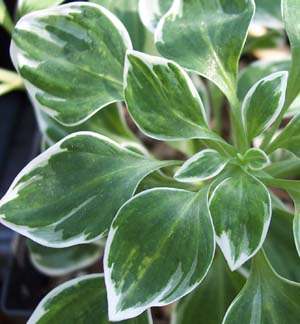 |
|
|
| Agave
victoriae-reginae (includes forms called Agave fernandi-regis) -
Queen Victoria's Agave - Hardy Succulent
The sculptural beauty of
plants is especially apparent in succulents. When reduced to their
essential elements, to survive in harsh climates, their forms become works
of art. Queen Victoria's Agave is such a masterpiece. In our
area, it grows best if given 8 to 10 hours of sun, along with a well-drained
root run. Their rate of growth is slow and their ultimate size is
under 2 feet in diameter. They flower after about 2 decades of growth
and most forms are killed by the effort. The few forms that survive
blooming develop secondary rosettes from underground stems to perpetuate
the clone. The handsome and variable progeny of the A. victoriae-reginae
X A. scabra cross are also well worth cultivating. |
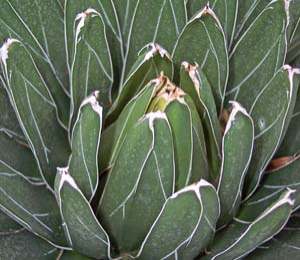 |
|
|
| Zantedeschia
aethiopica - Calla Lily - Perennial
Some say floral elegance
comes in many colors and forms. Others, of refined and exquisite
aesthetics, state it occurs in very few members of the Vegetal Kingdom
and not ever polychrome. But, regardless of your stance, most do
agree the Calla Lily is the essence of elegance. Despite its species
name, it is native to South Africa, to boggy or streamside habitats.
In cultivation in our zone, it also prefers 4 to 6 hours of sun (with protection
from the most intense afternoon sun). They spread by underground
stems and soon form colonies if provided with adequate nutrition.
Their aerial parts freeze and recovery can be slow the following spring.
I would mention their fragrance, but some might think less of them for
employing olfactory advertising to announce their exposing their reproductive
organs. |
 |
|
|
| Quercus
rysophylla - Loquat-Leaf Oak - Tree
This is one of the magnificent
oaks of Mexico. Specimens cultivated in Texas are usually derived
from acorns collected at several sites south of Monterrey, where it is
usually found from 4,600' to 6,200' elevation in the Sierra Madre Oriental.
It is a 50 to 80 foot tall tree with thick evergreen leaves said to be
similar in their texture and prominent venation to the Loquat. While
it generally grows near the streams that cascade down the narrow valleys
facing the Gulf of Mexico, carrying torrents of rain wrung from the clouds
through orographic lifting, it does exhibit some drought-tolerance.
This last dry year-and-one-half, my grove of seven trees fared as well
as the Q. polymorpha from the Devils River of Texas and better than
Q.
polymorpha from Mexico. Though local vendors rarely sell this
tree, it is often found in specialist nurseries in the Houston area.
The spelling of the species
used above is the correct version (as found in the original publication
of the name in 1910 by Weatherby), numerous variant spellings are employed
by ignorant individuals. |
 |
|
|
| Adiantum
capillus-veneris - Maidenhair Fern - Perennial Fern
A plant is said to be cosmopolitan,
not because it has been featured in a publication by that name, but because
it has an extensive range, especially one covering several continents.
This delicate fern is such a globe-trotter. Though it ranges from
North and South America to the Eurasian land-mass, its distribution is
spotty. If you find moist ledges, or rocks irrigated by a seep or
spring, you should generally see this plant. The colony illustrated
here is in Kendall County, near the spray of a waterfall cutting a channel
through limestone. If those are its needs, can it be domesticated?
Yes, it thrives near a water feature in the landscape and will even grow
on the sides of a natural stone fountain. Its specific epithet means,
"hair of Venus" and thus shares the same ancient root as "venerate" and
"venereal." |
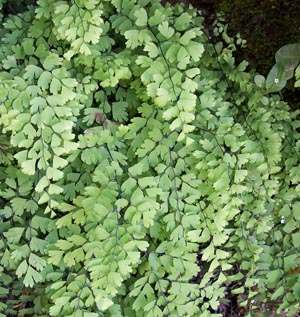 |
|
|
| Begonia
X 'Barbara Rogers' - 'Barbara Rogers' Begonia - Perennial
While I avoid using bedding
plants, especially annuals, around my home. My landscape still contains
familiar elements. However, mine are the perennial relatives of those
common bedding plants. Having so many shady beds (with varying degrees
of shade), the genus, Begonia, is well represented in our collections.
This particular cultivar grows best with morning sun and shade after 1:00
to 2:00 PM in our semi-arid climate. Unlike its bedding plant relations,
this hybrid grows 2' to 4' high. And, best of all, I bought it once
and have it return every spring. Do your begonias do likewise? |
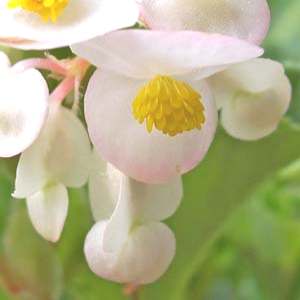 |
|
|
| Aster
oblongifolium - Fall Aster, Mexican Aster - Perennial
Fall flowers, especially
if displayed by members of the Sunflower Family, tend to toward the garish,
Halloweeny side of the spectrum. The so-called mums are anything
but mum when in bloom. This plant, however, a mainstay of old-fashioned
gardens in south-central Texas, requires no glacier goggles for viewing.
Also, its presence in the landscape does not call for a repeal of the time-honored
Laws of Color Harmony.
Unlike the New England Asters
sold locally by the big box stores and corporate-clone nurseries, this
one will actually thrive in our area. It needs full to half-day sun
and is very drought-tolerant once established. However, it does look
best if given a deep watering every week during a dry summer. |
 |
|
|
| Heimia
salicifolia - Huachinal - Shrub
This is another of the treasures
of the Sierra Madre. It's name might not ring any bells, but it will
be planted in more and more gardens in our area. Forms collected
from high elevations tend to be evergreen (except in extremely cold winters).
The 1" yellow blooms are borne throughout the growing season if water is
provided every two weeks. And, it has no known pests or diseases.
I maintain mine at 4' to 6' high, to see their blooms better. It
is a member of the Family, Lythraceae, thus related to Cuphea and
Crepe Myrtle. Hark, I believe I'm starting to hear distant tintinnabulation
or is it a tocsin, perhaps? |
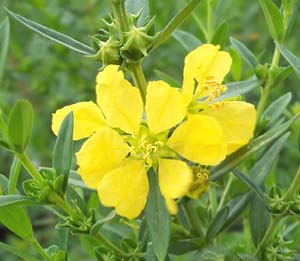 |
|
|
| Oxalis
crassipes - Pink Oxalis - Perennial
The mere mention of the word,
oxalis, and gardeners head for the potting shed in search of an herbicide.
I do the same when dealing with the native, yellow-flowered weed by that
name. However, the species illustrated here is far from being a weed.
In fact, it is a perennial long-cultivated and desired in our region.
It is also an extremely clever plant. It endures our hot, dry summers
by going dormant. Its aerial portions disappear with the last of
the spring rains and do not emerge until September's rains awaken them.
This species is also represented in gardens with a white-flowered form
as well as a clone with bi-colored petals (pink grading to white).
Give these low-growing gems at least half-day sun and a well-drained spot. |
 |
|
|
| Pseudogynoxis
chenopodioides - Mexican Flame Vine - Perennial Vine
Though older books call this
Mexican plant, Senecio confusus, I use its new name to avoid confusion.
Its 2.5" to 3" orange to orange-red flower heads are most abundant when
it is hot, but its fall floral display can be spectacular some years.
A perennial vine is one that usually freezes to the roots each winter and
recovers the following spring. However, the one I have near a southeast-facing
limestone wall has not been killed to the ground for 4 years - neither
has the Rangoon Creeper overhead. It grows best in full sun to at
least 6 hours of sun each day and requires a tree or trellis to climb.
Or, it can be allowed to spill down from above from the top of a retaining
wall. |
 |
|
|
| Acer
grandidentatum - Big Tooth Maple - Tree
Maples, especially to those
who grew up in the northern parts of the U.S., are desired landscape trees.
However, here in south-central Texas, their winter chilling requirements
and usual intolerance of high summer heat make them undesirable.
I am thankful there are a few exceptions. The Big Tooth Maples of
the Hill Country and mountains of northeast Mexico are adapted to this
area
IF they are given supplemental watering during droughts. Acer
skutchii, the Cloud Forest Maple of Mexico and Central America, requires
even more watering, and Acer truncatum, the Shantung Maple, is intermediate
in its irrigation requirements. |
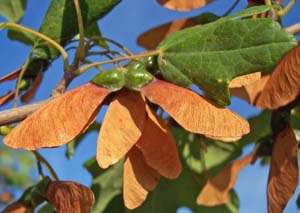 |
|
|
| Indigofera
kirilowii - Pink Indigo - Perennial
Based on its native habitat
of northern China and Korea, this legume seemed an unlikely candidate to
grow in semi-arid south-central Texas. It is a deciduous shrub most
years and becomes a perennial only when a severe freeze catches it before
it has become winter-acclimated. It is quite drought-tolerant in
afternoon shade sites and has the ability to grow in more sun if given
enough water. My most robust plants are almost 3' tall, but most
stay under 2'. The pink flowers occur on pendant stems from spring
to mid-summer. I first acquired this species to use as an understory
groundcover beneath tall bamboo - to embellish the area as well as to nourish
the bamboo. Since Pink Indigo is too beautiful just back there,
it has been transplanted to several other more prominent sites in our woodland
garden. |
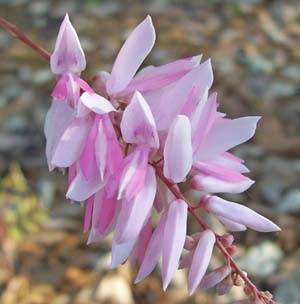 |
|
|
| Agave
bracteosa - Soft Agave - Hardy Succulent
Soft leaves, no thorns -
so unlike its kin, the Century Plants. This is one of my favorite
plants for a large outdoor container, since it NEVER needs to be watered
(though you could water it once each month during the growing season).
Individual rosettes can grow to over 2' in diameter and they do eventually
branch from below to form clumps. Grows best with some protection
from intense afternoon sun, in a location with good drainage. Requires
no supplemental irrigation once established. Again, these are perfect
plants for containers! |
 |
|
|
| Silphium
simpsonii var. wrightii - Golden Rosinweed - Perennial
A native Texas relative of
the 'Compass Plant' (Silphium laciniatum) with one to several 5'
to 6' flower spikes in late spring to early summer. The flowering
heads are surrounded by golden-yellow ray flowers - but non-botanists would
call them "petals". This prairie perennial is not browsed by deer
and looks good in combination with: Cherry Sage, Copper Canyon Daisy, Hybrid
Coral Bean (Erythrina X bidwillii), Lantana, Red Yucca, Rosemary,
Ruby Muhly, the larger Century Plants and Yuccas. Grows in full sun.
Looks best if given a deep watering every two weeks during a dry summer,
but can survive with no supplemental irrigation if well-established in
deep soils. |
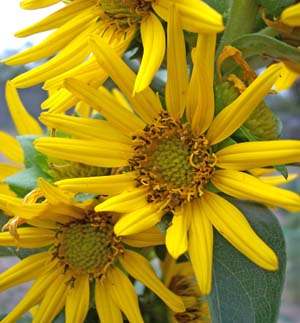 |
|
|
| Aristolochia
fimbriata - Fringed Pipe Vine - Perennial, Vine
If you wish to have Pipe
Vine Swallowtail butterflies in your landscape, you have to grow Pipe Vines
or, as some call them, Dutchman's Pipe. Botanically, they are members
of the genus Aristolochia. This species is the most diminutive
one hardy in our climate. While it can climb to over 12' in the tropics,
here it behaves more as a perennial groundcover in shady spots. It
is native to southern Brazil and adjacent areas of Argentina and Paraguay
and disappears after a freeze, returning from the underground parts in
early spring. One more thing, if you truly want the butterflies,
you must share the variegated foliage with their distinctive caterpillars! |
 |
|
|
| Strelitzia
reginae - Bird-of-Paradise - Tender Perennial
While this icon of tropical
landscapes is usually associated with practically frost-free sites, this
specimen was photographed in San Antonio. It is, of course, growing
in the ground in a very protected atrium. Like bananas, their distant
relatives, they have no aerial stems. The parts visible above ground
are leaf bases and leaf blades, with an inflorescence or two from time
to time. They grow best with afternoon shade and evenly moist soils.
Green sand (glauconite), volcanic minerals and paramagnetic minerals should
be incorporated into the medium around their roots. And please, have
a "Plan B" in case temperatures are likely to go below freezing for more
than a few hours in their protected micro-habitat. My Plan B would
be to dig up the clump, place the root-ball in a 15 to 20 gallon
pot and bring it inside until the arctic blast subsides. |
 |
|
|
| Crinum
procerum 'Splendens' - Red-Leaf Crinum - Tender Perennial
This splendid tropical Crinum
is a perfect choice for a pool-side planter. Just make sure you wheel
it to a protected enclosure when temperatures approach freezing.
In fact, it will require a heated sanctuary if prolonged freezing weather
is in the forecast. Otherwise, it is an almost perfect container
specimen. My established Crinum procerum 'Splendens' live
in 15 or 20 gallon pots and grow 6' high and wide by late summer.
I try to remember to feed them at least 4 times during the growing season
with a water-soluble fertilizer (in addition to the 8 to 10 Agriform 2-year
tablets each pot receives in spring). Give them 6 to 8 hours of sun
each day and a soaking when the huge leaves start to wilt. |
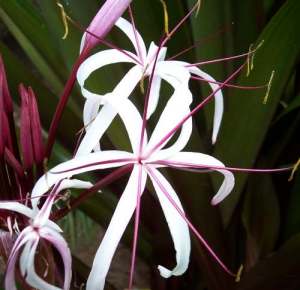 |
|
|
| Opuntia
imbricata - Tree Cholla - Shrub, Hardy Cactus
Tree Cholla is the most cold-hardy
large cactus of west Texas, New Mexico and Colorado. The largest
specimens reach almost 8' high and wide, composed of branching and re-branching
cylindrical stem sections. While it is in the same genus, Opuntia,
as prickly pears, that relationship is not apparent to the untrained eye.
Its purplish blooms of late spring give way to yellow "fruits" consumed
by wildlife. It should be planted only in sites receiving sun all
day and having perfect drainage. Propagation is very easy from stem
sections placed horizontally on the ground, or propped up vertically with
rocks or sticks. |
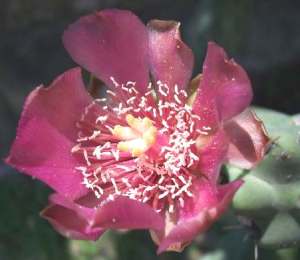 |
|
|
| Hibiscus
dasycalyx - Neches River Rose Mallow - Perennial
Hibiscus dasycalyx, or more
correctly, Hibiscus laevis var. dasycalyx*, is a very localized
variant found only in east Texas in Cherokee, Harrison, Houston and Trinity
counties. It occurs in seasonally flooded sites associated with the
Angelina, Neches and Trinity Rivers. The 4' to 7' stems bear many
flowers (4" to 6" across) during the hottest months of the year.
Like its relatives,
H. coccineus, H. laevis (militaris),
H.
grandiflorus and H. moscheutos, its stems die back in late fall
and resume growth from the rootstock in March to April. For best
floral development, all of these perennial mallows must be grown in full
sun. While they are native to areas that are flooded during part
of the growing season, they do very well in cultivation with weekly watering.
*American Journal
of Botany, Vol. 82, No. 11 (Nov., 1995) , pp. 1463 - 1472. |
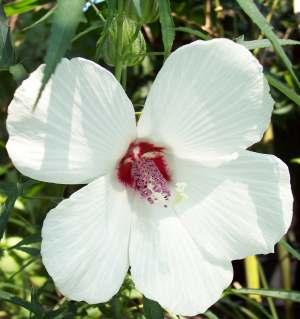 |
|
|
| Russelia
sp. (San Carlos Mountains) - Coral Firecracker Bush - Perennial
Is it hotter than a firecracker on the 4th
of July? Yes, and safer too. This species from the San
Carlos Mountains of the Mexican state of Tamaulipas is much larger
than the common Firecracker Bush, R. equisetiformis,
reaching up to 6' high and wide (if never trimmed). This plant can
be tall and self-supporting in very sunny sites or sprawling and pendent
in shade. Grows in full sun to less than half-day
sun, and it looks best if given a deep watering every two weeks during
a dry summer. Its best use is as a large-scale groundcover, especially
on slopes where its spreading and colonizing habit is used to advantage. |
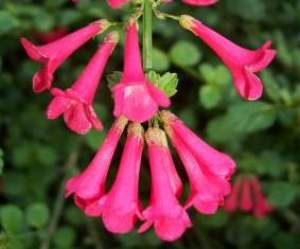 |
|
|
| Justicia
aurea - Giant Golden Shrimp Plant - Perennial
This native of Mexico and
central America is the second tallest member of the Shrimp Plant clan in
my collection. Only Megaskepasma erythrochlamys, 'Brazilian
Red-Cloak', grows taller. While it can grow to over 12' in
its tropical homeland, it manages to grow only to slightly over 8' here
in San Antonio. In a word, it is spectacular. It starts to
flower in late spring and by late June, it is a 4' to 6' multi-stemmed
shrub with a 6" to 8" "cone" of numerous 2.25"-long golden blooms at the
top of each stem. It grows best in this area with dappled morning
sun and afternoon shade and twice-weekly irrigation during summer droughts.
Do not let its water requirement keep you from growing this giant, it is
worth the 10 gallons per week! As with most tropical perennials,
mulch it deeply in late October and remove the mulch in early March.
Feed it twice in spring with 15-5-10 (6 weeks apart) to hasten its recovery. |
 |
|
|
| Salvia
guaranitica 'Black & Blue' - 'Black & Blue' Sage, 'Domestic Violence'
Sage, 'Domestic Violence' Anise Sage - Perennial
Salvia guaranitica is the
best blue-flowered shrub sage for semi-sunny sites with good levels of
soil moisture. The floral tubes are a beautiful shade of blue and
the calyx (floral cup) is almost black. In protected microhabitats, or
after a mild winter, this sage will begin flowering in April. Elsewhere,
it re-emerges in early spring and starts to bloom in mid- to late-summer.
The leafy stems can reach 8' tall by late fall with ideal levels of fertilization
(15-5-10 three times during the growing season). Other commercially
available cultivars and selections of this species include: 'Argentina
Skies', 'Blue Ensign', Brazil & Costa Rica. |
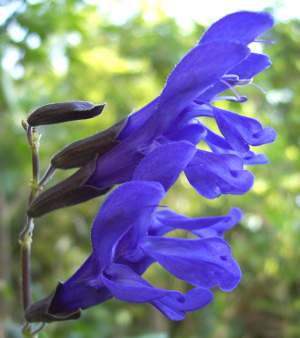 |
|
|
| Begonia
grandis 'Heron's Pirouette' - 'Heron's Pirouette' Begonia - Perennial
As described by Daniel J.
Hinkley, "We are very excited about this selection of the hardy Begonia
that was a standout amongst seedlings raised from our wild collections
in Japan in 1997. The inflorescence of hot pink flowers is over twice as
long as the typical species, to a full 12", and tumbles gracefully downward
from stems to 15" clad in lovely triangular foliage. Later, even the seed
heads transition to striking tones of pink. Best in partial shade and well-drained
soil. You will not be disappointed by this selection."
Dan Hinkley founded the Heronswood
Nursery in Kingston, Washington in the late 1980's and began offering plants
propagated from his vast collection by mail-order in 1991. That collection
expanded greatly as he traveled the world, searching for new and worthwhile
specimens.
This photograph of 'Heron's
Pirouette' was taken this afternoon (9 June 2006) in a shady corner of
my yard. It commences flowering in May and continues until first
frost. It is included here to honor the many contributions to horticulture
by Heronswood Nursery, as well as to note, with sadness, the news of its
abrupt closing. |
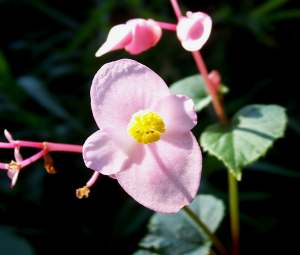 |
|
|
| Habranthus
robustus - Giant Pink Rain Lily - Perennial Bulb
Our native Prairie Rain Lily*
bears white flowers a few days after thunderstorms. It is so common,
some even consider it a weed, especially when it occurs in a lawn.
This species, from southern Brazil, blooms likewise. However, its
blooms are larger, pink and are borne on taller stalks. Though the
specific name is, robustus, 'robust' in Latin, it is not the most
robust one available. Some selections of Habranthus brachyandrus
are more robust, as is the cultivar, Habranthus robustus 'Russell
Manning'. All of these pink Habranthus, as well as their hybrids,
grow in full sun to half-day sun in well-drained soil. All expand
to form clumps (both by branching and division of the bulbs, as well as
by the germination of seed), giving you a surplus to share (or sell).
* It is known by two names,
Cooperia
pedunculata or Zephyranthes drummondii. |
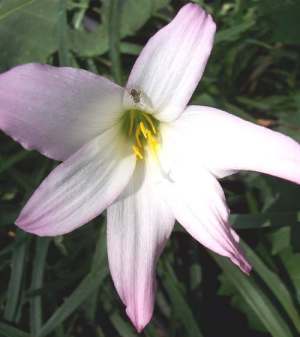 |
|
|
| Salvia
greggii X muelleri - Violet Cherry Sage - Perennial
A robust hybrid much like
Cherry Sage, Salvia greggii. It differs in flower color and
most clones usually have the aromatic and resinous leaves of S. muelleri.
Hybrid vigor allows it to grow to 3' high and wide. It looks
best if grown in full sun, but will still provide some blooms in half-day
sun. Probable cultivars and forms in cultivation are named: 'Burgundy',
'Dark Dancer' & 'Diane'. |
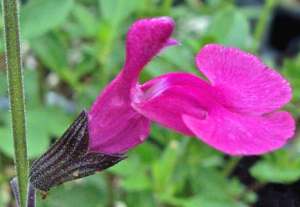 |
|
|
| Clerodendrum
bungei - Mexican Hydrangea - Perennial
It is not a real "hydrangea" nor is it from Mexico*,
but it's still attractive, even if misnamed. Please, just don't crush
the leaves of this deer-proof plant, they are as malodorous as those of
other ornamental species of this genus! The flower heads, produced
at the tops of 4' to 6' stems, occur from spring to late summer and can
be up to 8" in diameter. It does spread by rhizomes (underground
stems), thus forming a colony. Plant it where that habit will not
create a problem. While it can grow in full sun,
it needs far less water in half-day sun sites.
*Native to the misnamed, People's Republic of China.
It belongs to the Verbena Family. |
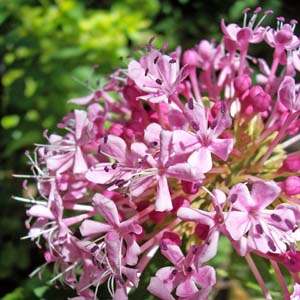 |
|
|
| Quercus
macrocarpa - Bur Oak - Tree
Bur Oak leaves, like the
leaves of other trees, contain the machinery of photosynthesis within structures
called chloroplasts. Employing an alchemy energized by light, plants
join water (H2O) and carbon dioxide (CO2) to make
sugars and oxygen (O2). Those sugars feed them, as well
as animals and parasites. Many humans (with pruners in hand) seem
ignorant of this basic fact of biology. They remove too many leaf-bearing
branches too soon. Trees DO NOT form superfluous branches with supernumerary
quantities of leaves. Please do not decimate your trees. Follow
the Trashy Trunk Technique and do not remove secondary branches until they
are 1" in diameter. The premature removal of secondary branches starves
saplings. |
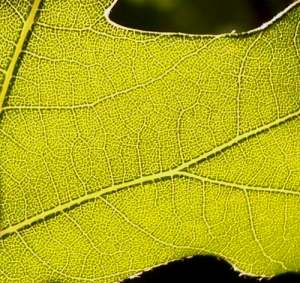 |
|
|
| Ratibida
columnaris - Mexican Hat - Perennial
This showy prairie perennial
can grow to 4' tall, and is most abundant on soils derived from limestone.
As a wildflower, it has one of the longest flowering times since it can
bloom from April to first frost, if rain is sufficient. Being a member
in good standing of the Asteraceae, the Sunflower Family, its "flower"
is really a compound structure bearing many individual flowers. The
"petals" are ray flowers (with no reproductive parts) and the inner blooms
are disk flowers with the potential to form achenes ("seeds"). The
rays can be all yellow to red-brown with a yellow edge or tip or entirely
red-brown. Please feel free to pull out excess seedlings, especially
those with ray flowers that clash with with your preferred floral color
scheme.
This is also called Ratibida
columnifera. |
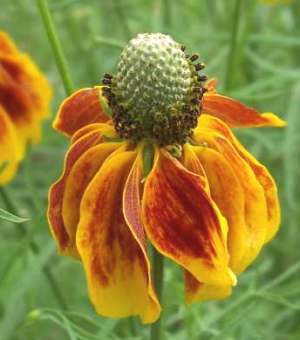 |
|
|
| Sprekelia
formosissima 'Orient Red' - 'Orient Red' Aztec Lily, Jacobean Lily - Perennial
Bulb
Sprekelia is truly one of
the most spectacular flowers one can cultivate in San Antonio. This
amaryllis relative is native to the Sierra Madre Occidental of Mexico and
is usually found on rocky slopes. My best flowering specimen is planted
just a few inches from a west-facing concrete sidewalk. Others report
great results from bulbs grown in rock gardens. It loves a hot exposure
and blooms in response to thunderstorms in late spring, summer and fall.
The cultivar, 'Orient Red', is much more floriferous than the typical selection. |
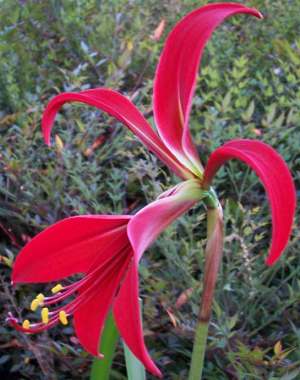 |
|
|
| Mimosa
borealis - Cat's Claw, Mimosa, Pink Mimosa - Shrub
This spring-blooming native
is a real Mimosa. The other one, the short-lived, shallow-rooted,
weak-wooded, borer-bait Asian tree called "Mimosa" is actually in the genus,
Albizia.
That abomination is known correctly as, Albizia julibrissin.
This mimosa occurs throughout the Hill Country of central Texas, as well
as in west Texas, New Mexico and Oklahoma. It is deciduous during
its winter dormant period and can also defoliate during long droughts.
Though this 4' to 6' shrub is very attractive when in flower, its numerous
recurved thorns (one author tried to diminish them by calling them prickles)
discourage me from including it in my landscape. Though that very
quality would be an asset if one were trying to keep out vagrants and trespassers. |
 |
|
|
| Salvia
regla - Mountain Sage - Perennial
While Mountain Sage is one
of the best fall-blooming salvias for central Texas, it can also flower
in spring after a winter with few freezes. The cultivated clones
from the Chisos Mountains in the Big Bend area of Texas are cold-hardier,
but forms collected in high elevation sites just southeast of Saltillo
(in northeast Mexico) are showier. This woody sage can grow 4' to 8' tall,
and needs perfect drainage plus afternoon shade. Cultivars and selections
include: Hidalgo, Jame, 'Mount Emory' & 'Warnock's Choice'. And
please, water this hummingbird plant only if wilted!
|
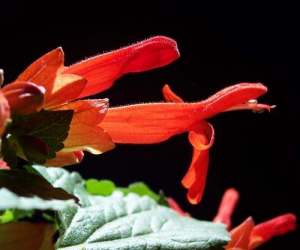 |
|
|
| Consolida
ambigua - Annual Larkspur, Rocket Larkspur - Winter Annual
A winter annual sprouts from
seed in late summer and fall, grows through the winter, and bolts, flowers
and sets seed in spring. Texas Bluebonnets and many other wildflowers
behave as winter annuals. Both Consolida and a related genus,
Delphinium,
have been given the same common name of 'Larkspur'. The perennial
Larkspurs, one is native to this area, are usually Delphinium.
This annual species is originally from the Mediterranean region, though
it is now naturalized in many parts of Asia and North America. A
pink flowered form of this species is also in cultivation. Rocket
Larkspur does best in full sun and can grow to 3 feet high in well-drained
sites.
|
 |
|
|
| Aquilegia
chrysantha var. hinckleyana - Hinckley's Columbine - Perennial
Though very few have seen
Capote Falls, many have seen a plant endemic to that oasis about 40 miles
west of Marfa. I obtained my first specimens of Hinckley's Columbine
in 1978 and cannot imagine a spring garden without its graceful presence.
A well-fed plant of this phenomenal perennial can grow to 5 feet wide and
almost 3 feet high. All it needs is afternoon shade, excellent drainage
and high levels of fertilization during its winter growing season.
The spurred blooms appear from late February to early June. |
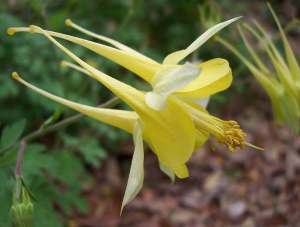 |
|
|
| Muscari
neglectum - Grape Hyacinth - Perennial Bulb
If you want to grow a Grape
Hyacinth, go to any nursery or mass merchant in the fall and buy all the
bulbs you can afford. If, however, you want a type of Grape Hyacinth
that thrives in our climate and limestone-derived alkaline soils, this
is the only one. Yes, some of the other species and hybrids will
linger here for a few years, but their fate is to decline and eventually
die out.
Though these plants are small,
6" to 8" high, they multiply and self-sow to form large colonies in time.
In spite of their size, they are quite prominent this year since the Texas
Bluebonnets are scarce after a dry fall and winter. Mine have been
in bloom since mid-February and should continue until early April.
This Grape Hyacinth is dormant in summers and grows from November to April.
If you acquire some of these bulbs, make sure they are planted where they
receive at least half-day sun during their growing period.
|
 |
|
|
| Setaria
poiretiana - Mexican Palm Grass - Perennial to Half-Hardy Ornamental Grass
This outstanding ornamental
grass has leaves pleated like palm foliage. The clumps, if well fed,
can grow to 6' wide and 3' high, but are usually only 4' across.
The selections of this species grown from seed I have collected in high-elevation,
cloud forest habitats in central Mexico grow very well in San Antonio and
Austin. They will often self-sow and re-sprout from below after all
but the coldest winters. S. poiretiana is significantly more cold-hardy
than Setaria palmifolia, the Asian species of Palm Grass usually
sold in the U.S. Grows best with shade in late afternoon. And,
it looks best if given a deep watering every week during a dry summer (though
it needs less water in more shade). Mulch deeply in late fall to
provide winter protection and remove the excess mulch in late winter. |
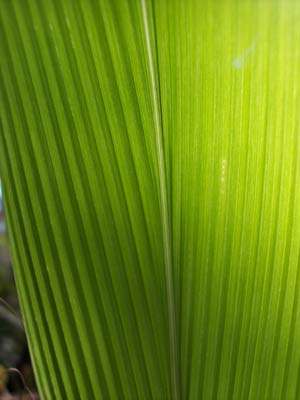 |
|
|
| Aquilegia
dichroa - Lusitanian Columbine - Perennial
To me, the word 'Columbine'
evokes images of montane meadows, slopes of tall conifers and snowy peaks.
And that association is true for many species of the genus. Those
are the ones that will die if planted in south-central Texas. This
one, however, is a durable Columbine. It thrives in our winters and
survives our summer heat. This remarkable spring-blooming native
of Portugal requires a shady site, good drainage (add decomposed granite)
and a deep watering every two weeks during dry spells. It will self-sow
in ideal locations.
|
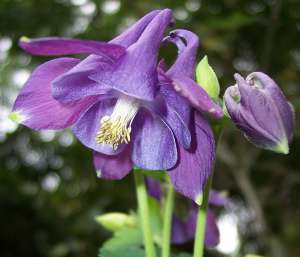 |
|
|
| Tetrapanax
papyrifera - Rice Paper Plant - Perennial
It's the amazing mathematics
plant! It multiplies. It adds. It even responds to division!
And it truly will subtract from the space available for nearby plants.
In other words, it spreads
- increasing mightily by underground stems. Ordinarily, I dislike
such botanical abundance. But, I have made an exception for just
one particular clone of this species.
The typical Rice Paper Plant
grows 8' to 10' high with large leaves resembling those of the Castor Bean
Plant. This gigantic clone can reach up to 25' high with 3' to 5'
leaves. Its spreading by rhizomes is not a problem for me since any
wayward stems are dug up and potted. I react to their emergence exactly
as a child does to Christmas presents.
Both the standard and giant
forms do best with dappled sun or morning sun/afternoon shade and prefer
a deep watering every week during a dry summer. All respond well
to generous levels of fertilization and rich soil. |
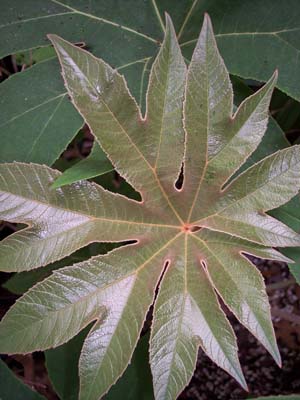 |
|
|
*
|
. |

